Online Magazine
Recent Posts
- Safeguard your Cellphone Photos
- Black & White to Color – Instantly
- Wearing Many Hats
- Video Roundup
- Rescuing Your Blurry Pictures
- Showing Their Age
- What is Your Angle?
- Panorama Photos
- Humorous Photos
- Close Ups
- Fisheye Pictures
- Photo Antiquities
- Printing Big
- Appreciating Scale
- Celebrity Sightings
Tags
More Places to Go
- Free "How-To" Books “How To” books for popular cameras 0
- Vist Us on Facebook keep in touch with us on Facebook 2
Archives
- July 2023 (1)
- March 2023 (2)
- February 2023 (1)
- December 2022 (1)
- October 2022 (1)
- September 2022 (8)
- August 2022 (9)
- July 2022 (1)
- June 2022 (1)
- June 2021 (1)
- May 2021 (1)
- March 2021 (5)
- February 2021 (4)
- January 2021 (2)
- April 2019 (1)
- March 2019 (1)
- February 2019 (1)
- October 2018 (2)
- April 2018 (1)
- March 2018 (4)
- February 2018 (1)
- November 2017 (1)
- August 2017 (1)
- June 2017 (1)
- April 2017 (1)
- March 2017 (5)
- February 2017 (2)
- January 2017 (1)
- October 2016 (1)
- September 2016 (1)
- August 2016 (1)
- July 2016 (1)
- May 2016 (1)
- April 2016 (1)
- March 2016 (2)
- February 2016 (1)
- January 2016 (2)
- December 2015 (1)
- November 2015 (1)
- October 2015 (3)
- April 2015 (1)
- March 2015 (5)
- February 2015 (1)
- January 2015 (4)
- December 2014 (2)
- November 2014 (5)
- October 2014 (2)
- September 2014 (1)
- August 2014 (2)
- July 2014 (1)
- May 2014 (1)
- April 2014 (5)
- March 2014 (5)
- December 2013 (2)
- November 2013 (18)
- October 2013 (1)
- September 2013 (1)
- August 2013 (1)
- July 2013 (1)
- June 2013 (3)
- May 2013 (1)
- April 2013 (2)
- March 2013 (1)
- February 2013 (1)
- January 2013 (1)
- December 2012 (1)
- November 2012 (2)
- October 2012 (2)
- September 2012 (5)
- August 2012 (2)
- July 2012 (1)
- June 2012 (1)
- May 2012 (1)
- April 2012 (4)
- March 2012 (1)
- February 2012 (1)
- January 2012 (3)
- December 2011 (1)
- November 2011 (3)
- October 2011 (1)
- September 2011 (2)
- August 2011 (2)
- June 2011 (3)
- May 2011 (4)
- April 2011 (8)
- March 2011 (8)
- February 2011 (10)
- January 2011 (6)
- December 2010 (11)
- November 2010 (14)
- October 2010 (6)
- September 2010 (12)
- August 2010 (2)
- July 2010 (4)
- June 2010 (3)
- May 2010 (1)
- April 2010 (1)
- March 2010 (2)
- February 2010 (1)
- January 2010 (1)
- December 2009 (1)
- November 2009 (2)
- October 2009 (2)
- September 2009 (1)
- August 2009 (3)
- July 2009 (2)
- June 2009 (1)
- May 2009 (2)
- April 2009 (1)
- March 2009 (2)
- February 2009 (1)
- January 2009 (3)
A Walk around CES – Part 1
20th January 2012
The 2012 Consumer Electronics Show
| My first Consumer Electronics Show was in 1982 when the numbers were a lot smaller than the record breaking 150,000+ that made their way to this year’s event. This crowd was at CES to see more than 3,000 exhibitors displaying their new products. |  |
| You’d think I might be weary of CES after 30 years, but I still find excitement in talking to these exhibitors who are making cool stuff that will be on retailers’ shelves in coming months. | |
| CES is huge. This year’s show took up some 1.8 million square feet of space in the Las Vegas Convention Center and several other nearby venues. That’s a lot of walking and so I was sure to wear some comfortable shoes. | |
| This year’s attendance may have been boosted by members of the Photographic Marketing Association. The PMA chose to co-locate their yearly gathering at CES for 2012. Since most of the major photo equipment manufacturers already exhibit at CES, it makes sense for the PMA to join forces.
For the first time that I recall, the show was held from Tuesday thru Friday instead of over a weekend. I’m told that the casinos pushed to “clear” the weekend for other guests because CES folks are not known to be big gamblers. |
|
| Before beginning my walk, I stopped at the press room to review some of the hundreds of exhibitor press releases. As you can see in this photo to the right, the Press Room was a busy place filled with 150 or so reporters at any one time. Many were already sitting at workstations with their laptops and wireless connections filing articles and stories.
CES management goes to great lengths to help deliver the marketing message of these exhibitors to the consumer. The flurry of activity in the press room is what eventually fills the airwaves, printed newspapers and magazines with buzz about these new electronic gizmos. |
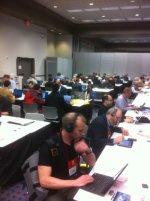 |
| In Part 1 of my report, I’ll mention the photographic items that caught my eye. Excuse me, if I resort to “technicalese” while describing some of the higher end products.
After reading this article, go to A Walk around CES – Part 2 where I cover a few of the other cool gadgets.
What follows is a quick rundown of some of the new or upcoming photographic products that I found interesting. |
|
|
|
|
| Wireless products were all over the show. Here’s a pair of products from Kodak that take advantage of wireless. | |
|
 Kodak’s Hero printer conveniently connects to your router wirelessly. And by assigning it an email address, you can also send send images to it remotely. |
| The M750 camera can also talk to a mobile device such as a smartphone. Then you can use the free app on your mobile device to forward your images to a backup computer or other online apps such as Kodak Gallery, Picassa, Facebook or Flickr. Here’s where you can find out about the Kodak M750 camera. | |
|
|
|
|
 Skiers can wear their Apex HD model which embeds wifi and GPS into the goggles and also shoots 1080p HD video. Inside the goggles is a small LCD that is visible to skier, $395. |
| Liquid Image has other models specifically fore underwater, bicycling and other outdoor sports. For more information, go to Liquid Image. | |
|
|
|
|
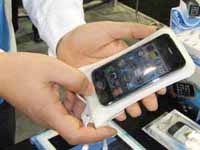 This is WP-MS10 case is for smartphones and can withstand water to depths up to 30 feet. If you can talk under water, I guess it’s useful for emergency phone calls 🙂 Price about $25. |
| DiCAPac makes other waterproof cases for the iPad, compact cameras and other electronic devices as well. For more information, go to DoCAPac. | |
|
|
|
|
 This is their Hero 2 model which can be accessorized to mount many different ways: wristband, helmet, bicycle, surfboard, airplane wing, you get the idea. Price is $295. |
| If you would like to see an action video captured with the Hero camera, click here (courtesy of Eastern Sierra Guiding.
GoPro has many accessories for adapting the Hero 2 to a multitude of uses. For more information, go to GoPro. |
|
|
|
|
|
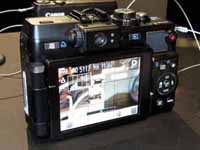 The G1X has a 4X optical zoom f/2.8 lens that couples to the optical viewfinder, captures RAW images at 4.5 frames per second, offers full manual control, features a swiveling 3″ LCD screen and records 1080p HD video with stereo sound. |
| The G1 X will be available in February for $795. For more detailed information, visit Canon G1 X. | |
|
|
|
|
 The D4 has an integrated “battery grip”, ISO sensitivity to 12,800, captures 10-11 frames per second for up to 20 seconds, uses a new 51-point continuous autofocus mechanism and records 1080p HD video with stereo sound. |
| I’m told that this new model will be available sometime in first quarter 2012. For more detailed information, visit Nikon D4. | |
|
|
|
|
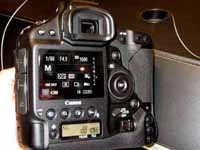 The 1D X has a new 61 point autofocus system and extensive HD video controls for professional recording. Like the Nikon D4, it has an integrated “battery pack” which make it quite a bundle to hold. |
| The 1D X will be available in April for a wopping $6800. For more detailed information, visit Canon 1D X. | |
|
|
|
|
The features of the X-Pro 1 that I like are its compact, lightweight body, 16MP APS-C size sensor dual optical/electronic viewfinder. The body style is retro rangefinder, similar to a sleek Leica M-series with easy to operate shutter speed dial and aperture settings on the lenses. The sensor has ISO settings to 25,600.
As I used the X-Pro 1, I thought it was larger and heavier than the other ILCs from other companies. I was surprised to learn that it lacks image stabilization, neither in the camera body nor the lenses. |
| The Fuji representative told me that the X-Pro 1 will be available late first quarter 2012, price $1700 for the body. For more detailed information, visit Fuji X-Pro 1. | |
|
|
|
| The NEX-7 is the company’s newest interchangeable lens camera (ILC). Since it does not have a mirror like a DSLR, the NEX-7 is very compact.
As a side note, based on my overwhelming positive experience with the Sony Alpha A55 over the past year, I preordered the company’s NEX-7 last October. Unfortunately, its release was delayed. At the show, a Sony representative told me that shipments have started so I hope to take delivery of one soon. |
|
|
 While the NEX-7 has a large LCD as seen here, most of the time I prefer to use the viewfinder. In addition to the newer E-mount lenses, an accessory that looks promising is the LA-EA2 lens adapter for attaching any of their standard A-mount lenses. This adapter has the same translucent mirror in the Alpha A55 and provides full-time, high-performance phase-detection autofocus (translation: fast and accurate). |
| The NEX-7 is available in limited quantities now with a 18-55mm E-lens for $1395. For more detailed information, visit Sony NEX-7. | |
|
Do you want to read more about CES? Go to Part 2 in which I describe a few of the non-photographic products that I found interesting. |
|
Written by Arnie Lee
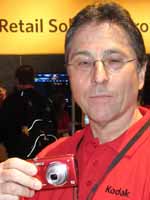
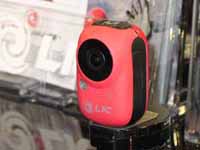

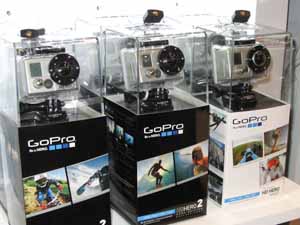

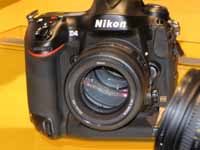
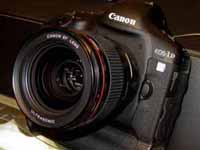


I don’t know much about the Nex-3 but the Nex-7 is already on order. It has many more features that I’d like compared to the Pen series.
Comment by admin — February 9, 2012 @ 12:16 pm